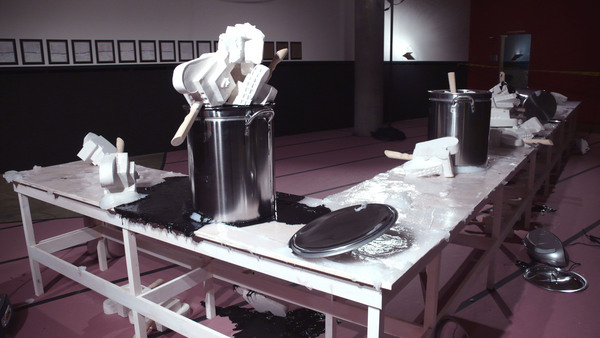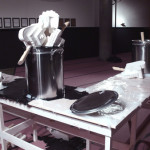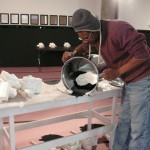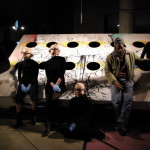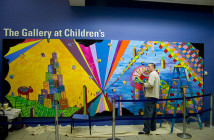WILLIAM POPE.L: CORBU POPS
In his exhibition Corbu Pops, artist William Pope.L launches an assault on the show’s venue, Harvard’s big sandy-gray Modernist bastion, the Carpenter Center for Visual Arts. The building is the only structure in North America designed by architect Le Corbusier, and Pope.L, who is known for his confrontational and interventionlist performances, aims below the belt.
At the center of the show are several breadbox-sized models of the building that Pope.L created. In each plaster-cast replica, a foot-long, phallic rod extends from a crotch formed by one of the building’s copious curves and corners. The objects resemble gigantic lollipops (Corbu-pops) when observed upright, but when speaking, Pope.L refers to them as both ‘hatchets’ and ‘war tomahawks’ to emphasize their maleness. With Corbu Pops, he wants to simultaneously critique masculinity and Modernism, which Pope.L believes are inseparable, and of which he believes the building is a potent symbol. To Pope.L, masculinity structures Modernism’s representation both in the art it begat and the language used to define it. He intended, in his words, to give the work a “sense of the certain qualities about manhood.”
“Even though Modernism was supposed to be a real radical thing - a rejection of the enlightenment and blah, blah, blah,” he said in a phone interview, “it still dealt within the culture of the great man.”
Pope.L said the potency of the Carpenter Center’s design left him with no choice for his approach to creating work within it; his installation had to create tension with the building and its architect otherwise his work would end up repeating them. Modernism did indeed raise the stakes of authorship by pushing the concept to a supernatural extreme (Think Rosalind Krauss’ “Myth of the Avant Garde”) and it is next to impossible for any encounter with the ostentatiously shaped edifice to leave any visitor without some sense of the building’s imposing form.
One way to enjoy the exhibition is to consider its concomitant critique of modernism and masculinity. Pope.L show mocks the supreme authorship of Modernists and architects alike and throws into the question the basic premise of modernism: the individual as original or transcendent creator. He said, “You could say that what architects actually do is they name buildings. In a sense, in naming buildings, the building comes to be. And great men, that’s what they do. They name things.”
The politics of naming and categorization of knowledge is a theme that resonates throughout the installation. The phallic nature of the “Pops” is only one entry point for an installation that seeks to unsettle the viewer’s sense of Modernism. The work, however, is so scatterbrained that it seems Pope.L would be satisfied to see viewers leave confused.
For example, the name Corbu Pops, in addition to hatchets, could also refer to the chorus of Harvard undergraduates who appeared at the opening in the giant wack-a-mole table that is part of the installation. They dressed in grotesquely rendered Le Corbusier masks and screamed in unison under the direction of Pope.L. There’s also a coating of petroleum jelly on the table where the Corbu-hatchets rest that glistens under the hot glare of stage lighting. Why? Use your imagination. Just about any interpretation of the protective or lubricating fossil fuel bi-product is applicable here.
“One of the things Pope.L’s work is trying to do,” said Helen Molesworth, the show’s curator, “is use confusion and nonsense to slow you down so maybe you realize, ‘wow I don’t know what’s going on’ and in not knowing something or in being asked to rethink something you thought you knew, there’s actually a potential for change.” That potential, though enormous considering the diversity of elements in the installation, will allow many a viewer to pass through the exhibit without gaining the new perspective that the politics of Pope.L call for.
- William Pope.L, Corbu Pops, 2009. Image courtesy of the Carpenter Center for the Visual Arts and William Pope.L. Photo by Shiloh Cinquemani.
- William Pope.L, artist at work on Corbu Pops, 2009. Courtesy of the Carpenter Center for the Visual Arts and William Pope.L. Photo by Shiloh Cinquemani.
- William Pope.L, performance of the “Corbu Pops,” 2009. Courtesy of the Carpenter Center for the Visual Arts and William Pope.L. Photo by Shiloh Cinquemani.
A slightly truncated version of this article originally appeared in the March 18 2009 issue of Boston's Weekly Dig.
"Corbu Pops" is on view through April 5, 2009.
All images are courtesy of the artist and Carpenter Center for the Visual Arts.

